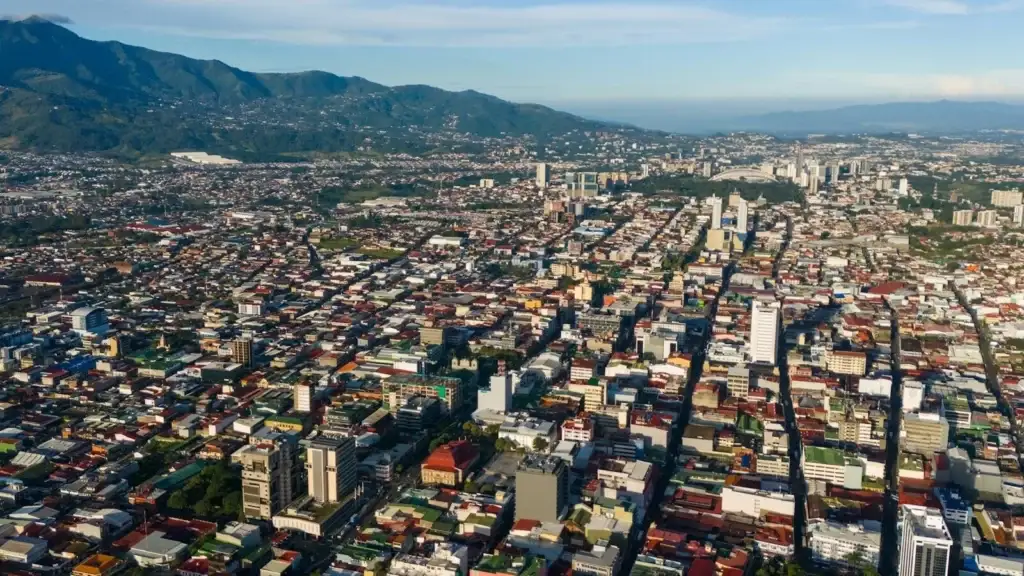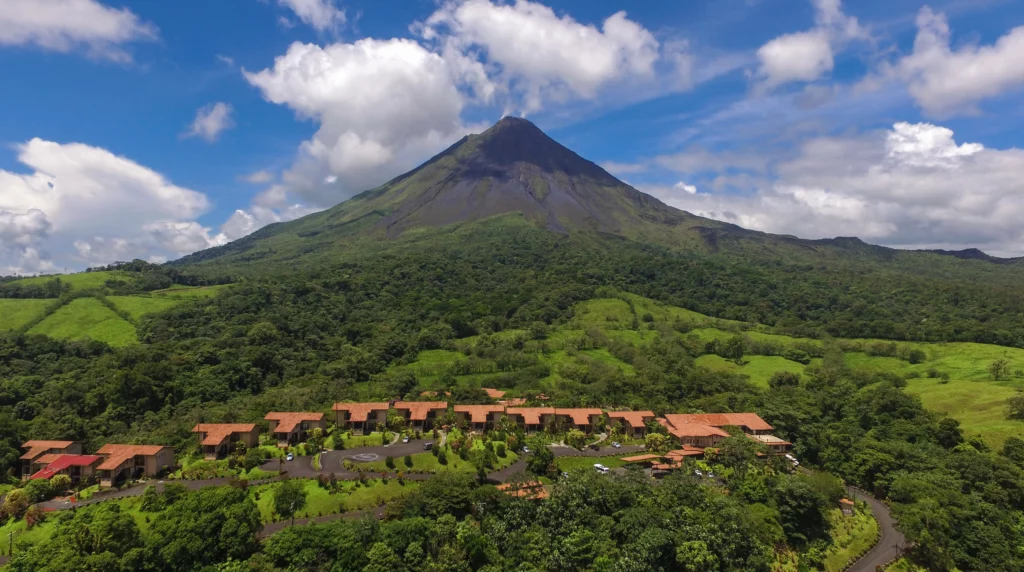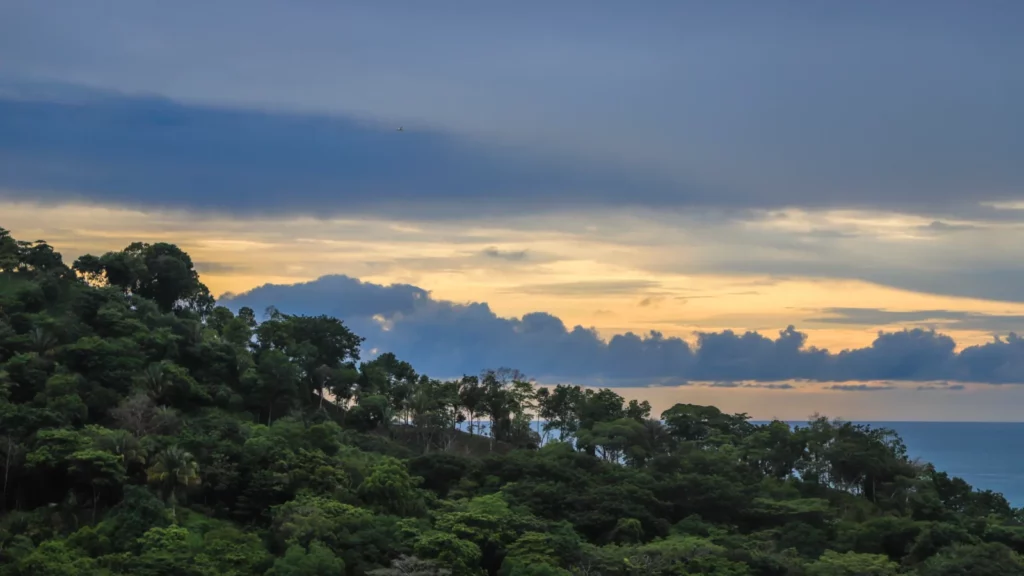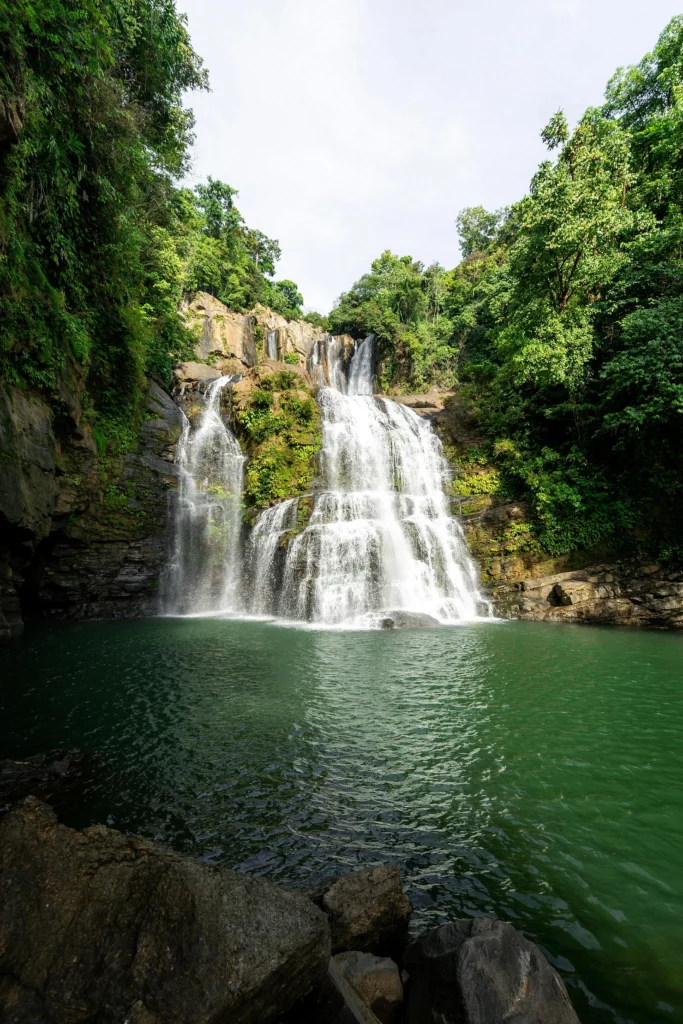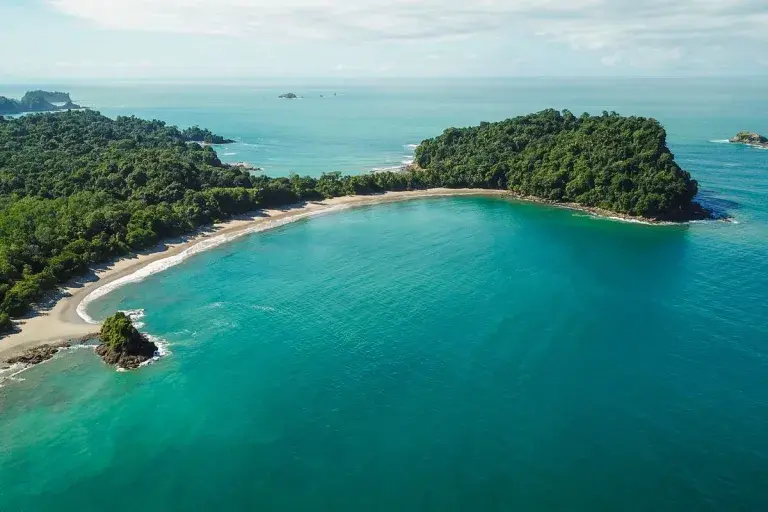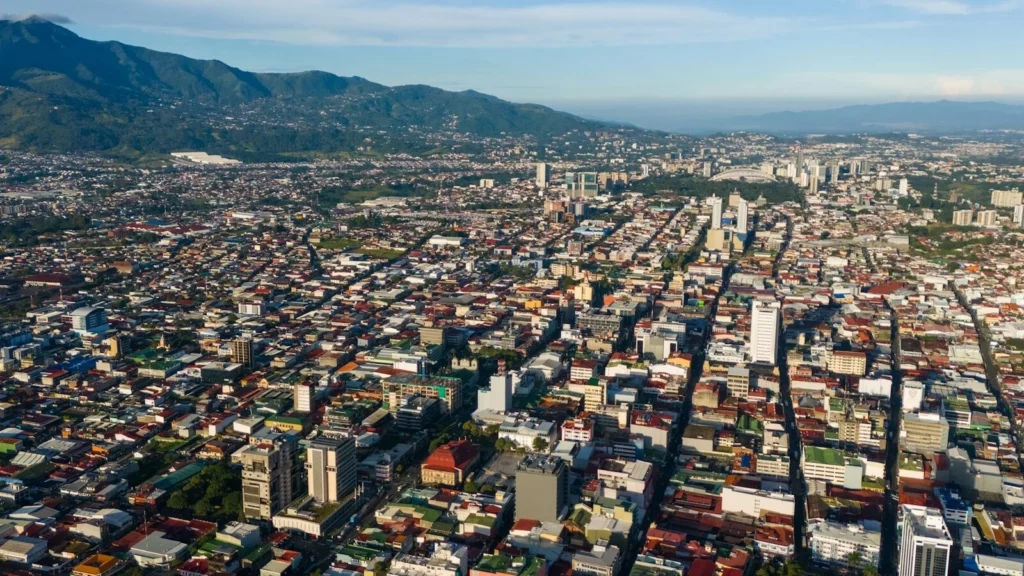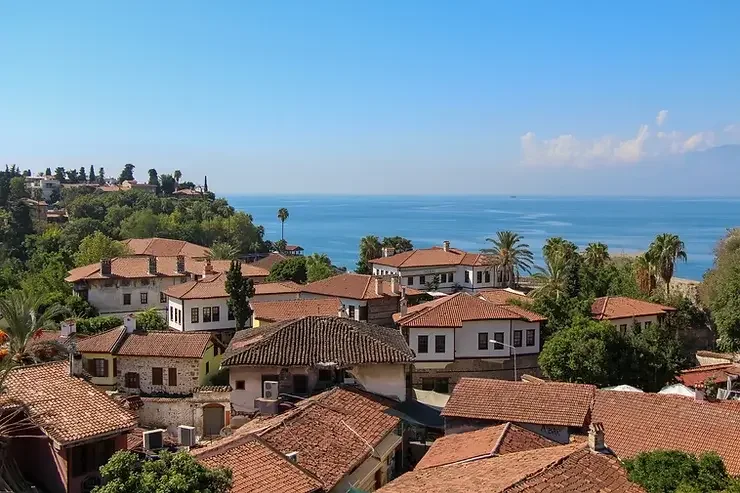Costa Rica’s Central Valley is an attractive place to invest thanks to its pleasant climate, world-class infrastructure, and the warmth of its people.
As the country’s central hub, it offers access to cutting-edge services, reliable transportation, and high-quality healthcare and education. The area exudes safety and well-being through the “pura vida” lifestyle and the hospitality of its residents.
Investors can explore opportunities in ecotourism, agriculture, culture, and the thriving real estate sector. For those looking to invest in Costa Rica’s promising future, the Central Valley offers an excellent quality of life with a rich cultural scene and exquisite regional cuisine.
Introducing Our Central Valley Communities
San José, Escazú, Atenas, Santa Ana, Ciudad Colón, San Ramón, Grecia, and La Fortuna.
From a bustling urban center to a peaceful soak in volcanic hot springs.
San José
San José is Costa Rica’s urban jungle, with commercial buildings and structures contrasting against the country’s lush green mountains.
Driving through the main roads, you’re surrounded by Costa Rican beauty, constantly reminded of the glorious nature just beyond.
Living in San José means instantly immersing yourself in Costa Rican culture, being among the people, and quickly feeling integrated. You won’t feel like a stranger for long. It’s the heart and center of Costa Rica.
San José is made up of many neighborhoods. The city itself is crowded, dense, and small, so most expats typically don’t choose to live here. For that reason, there are few expats residing in downtown San José.
Escazú
The settlement of Escazú began in the 16th century, when the Huetar tribes named it Itzkatzu, meaning “resting stone,” as it became a stopping and resting point for early tribes traveling across the country.
Today, around one thousand Huetar descendants remain in the Escazú area.
The town received its official name and certification in December 1848. It has since become a charming and exclusive version of Costa Rica’s natural beauty.
It’s a suburb west of the capital, San José, close to less urbanized areas, offering stunning views of the surrounding mountain ranges. Escazú sits at an elevation of 1,101 meters, providing its 45,000 residents with a tropical climate year-round.
Atenas
The picturesque town of Atenas, in Alajuela, has long been a hidden gem nestled in the mountains of Costa Rica’s stunning Central Valley.
Located less than an hour west of downtown San José and just minutes from the modern toll highway that leads to the capital or the beaches.
When AARP named it one of the best places to retire abroad in 2010, the secret got out. Fortunately, it still retains its small-town charm.
Known for its year-round temperate climate, both retirees and locals have found
Atenas to be Costa Rica’s temperate “sweet spot.” The city has attracted more
residents since the long-awaited Caldera Highway was completed. The highway,
which runs from Ciudad Colón, south of Alajuela, to Puerto Caldera on the
Central Pacific Coast, cuts the travel time between the Central Valley and the
coast. But even before the new road, Atenas was less than two hours from many
beaches.
San José
San José: Trinity of Climate, Proximity and Entertainment
The climate: when you are in San José, you are almost 4,000 feet above sea level
which is just under 1,200 meters. This impacts the climate and as a result
temperatures in San José do not fluctuate as much as in the lower coastal
regions. You can enjoy a moderate temperature range all year round.
No need for a car: Everything is within walking distance. And if you are not in
the mood for walking, use buses – they are plentiful and cheap. Taxis are also
affordable.
Excellent shopping and entertainment facilities: Shopping and dining out are
the best here. Bakeries, fruit and veg stalls, craft beers and coffee houses are
abundant.
Coffee, Chocolates, and Beyond: Exploring San José and its
Charming Suburbs
If you want the best coffee in Costa Rica or love to enjoy the mastery of some
exclusive chocolatiers, San José is where you need to be.
Then, of course, there’s Avenida Central – 11 blocks of a pedestrian-only
walkway packed with department stores, pharmacies, clothing stores, more shoestores than you can count, book stores, jewelry stores, electronics stores, –
anything you can only want.
However, living in a packed city is not everyone’s cup of tea. Many expats prefer
the suburbs and little towns just outside San José.
Escazú
Escazú: Where Timeless Charm Meets Modern
Sophistication in Costa Rica
Escazú is a three-town cantón, or county, of the same name. The main, most
active area is Escazú City Center, with San Rafael de Escazú lying north, and San
Antonio de Escazú lying south. These three divisions blend together into a
thriving, interesting, and attractive composite. Real estate in the city varies from
century-old adobe houses, now being restored, to modern high rises, apartment
complexes, and upscale, attractive homes, all nestled between the two mountain
ranges that define the Central Valley. This setting—with its scenic outlooks,
narrow and twisting valley roads, and the charm provided by architecturally
beautiful churches and adobe buildings—merges with the style of contemporary
high rises to show that the city can be modern, but you still feel firmly at home
in Costa Rica.
Atenas
Mountain Paradise: Exploring the Historic Trails and Ideal
Climate of Atenas, Costa Rica
Surrounded by mountain sides of sugarcane and coffee, the town is located on
the old historic oxcart trail, which was the primary transportation route to bring
coffee to the ports on the Pacific and Caribbean sides in the 1800s. Although you
still see working oxcarts, the route has long been replaced with well-maintained
paved roads. The trip to trendy, suburban Escazú takes approximately 30
minutes—where expats utilize the best of Costa Rica’s shopping, fine dining, and
healthcare. It is also 30 minutes from the country’s main international airport
(SJO), in nearby Alajuela. The closest Pacific beaches are an hour away, making
its location hard to beat anywhere in the entire country. Nearly everything is
located within an hour or less.
Located at a pleasant, mosquito-free altitude ranging from 2,280 to 4,000 feet
and with maximum temperatures reaching the low-to-mid-80s F and
minimums rarely below 65 F most homes do not require heat or air
conditioning. The seasons mirror the rest of the country with the driest months
being mid-November through mid-May, with varying amounts of precipitation
the other months (September to October being the wettest). The weather,
altitude, and volcanic soil make it a perfect coffee growing environment.
Nature’s Perfection: A Coffee Paradise with Ideal WeatherLocated at a pleasant, mosquito-free altitude ranging from 2,280 to 4,000 feet
and with maximum temperatures reaching the low-to-mid-80s F and
minimums rarely below 65 F most homes do not require heat or air
conditioning. The seasons mirror the rest of the country with the driest months
being mid-November through mid-May, with varying amounts of precipitation
the other months (September to October being the wettest). The weather,
altitude, and volcanic soil make it a perfect coffee growing environment.
Atenas: A Growing Expat Haven with Expanding Educational
Opportunities and Vast Climates
Atenas has a strong expat community (estimated 2,500 full or part-time) of
mostly retired foreigners, but you will also see some younger families moving
into the area. With an uptick of younger families moving to Atenas, there is a
larger need for schools. You will find public elementary schools and high schools
in Atenas, as well as several private bilingual Spanish-English schools: Green
Valley School (pre-school, elementary, and high school) San Rafael Bilingual
High School, and Colina Azul School (pre-school & elementary.)
Known for its year-round temperate climate, both retirees and locals have found
Atenas to be Costa Rica’s temperate “sweet spot.” The city has attracted more
residents since the long-awaited Caldera Highway was completed. The highway,
which runs from Ciudad Colón, south of Alajuela, to Puerto Caldera on the
Central Pacific Coast, cuts the travel time between the Central Valley and the
coast. But even before the new road, Atenas was less than two hours from many
beaches.
Coffee & Charm: The Enchanting Town
Surrounded by mountain sides of sugarcane and coffee, the town is located on
the old historic oxcart trail, which was the primary transportation route to bring
coffee to the ports on the Pacific and Caribbean sides in the 1800s. Although you
still see working oxcarts, the route has long been replaced with well-maintained
paved roads. The trip to trendy, suburban Escazú takes approximately 30
minutes—where expats utilize the best of Costa Rica’s shopping, fine dining, and
healthcare. It is also 30 minutes from the country’s main international airport
(SJO), in nearby Alajuela. The closest Pacific beaches are an hour away, making
its location hard to beat anywhere in the entire country. Nearly everything is
located within an hour or less.
Atenas: Where Expat Dreams Meet Growing Families and
Education
Atenas has a strong expat community (estimated 2,500 full or part-time) of
mostly retired foreigners, but you will also see some younger families moving
into the area. With an uptick of younger families moving to Atenas, there is a
larger need for schools. You will find public elementary schools and high schools
in Atenas, as well as several private bilingual Spanish-English schools: GreenValley School (pre-school, elementary, and high school) San Rafael Bilingual
High School, and Colina Azul School (pre-school & elementary.)
Santa Ana
Santa Ana: Where City and Nature Embrace in Costa Rica’s
Valley of the Sun
Noted for its verdant mountains and constant breezes, Santa Ana is one of the
Central Valley’s top suburbs for expats who desire a blend of city and nature.
Located just ten minutes west of bustling Escazu and 15 minutes from
downtown San Jose, Santa Ana has experienced considerable commercial
growth in the last five years. Affectionately called the Valley of the Sun, Santa
Ana is celebrated for its warm, dry weather, abundance of outdoor activities,
and provincial charm.
Santa Ana’s residents are diverse, and housing is designed to meet every need:
choose between traditional neighborhoods, country estates, or upscale, gated
communities. No matter where you live, you’ll enjoy a high standard of living
and access to advanced technologies like high-speed Internet, 4G cell
phone coverage, and cable television.
Compared with other San Jose suburbs, Santa Ana’s cost of living is moderate to
high. Rents in central neighborhoods start around $450 – $500 for a furnished
one-bedroom rental, while an unfurnished luxury home can go from $1,500 –
$2,500 per month. However, Santa Ana residents readily agree that the extra
cost is worth it: the municipality is ranked as the country’s second best, thanks
to efficient use of taxes and some of Costa Rica’s best public services.
Healthcare and Climate in Playas del Coco: Accessible
Medical Options and Year-Round Tropical Living
Public transportation to and from Santa Ana is convenient and inexpensive.
Every few minutes, buses head west toward Ciudad Colon, while eastbound
stops include Escazu, Rohrmoser, Sabana, and downtown San Jose. Commuters
take advantage of the urban train that connects nearby Rohrmoser to San Jose’s
eastern suburbs. Additionally, the new Caldera Highway provides fast access to
the Pacific Coast – drive from Santa Ana to Puntarenas in about 70 minutes.
Santa Ana’s greatest draws are its beautiful weather and spectacular landscape
that beckon residents to spend time outdoors. The area is considered San Jose’s
horse country, and several equestrian centers and small ranches dot the
countryside. The most notable is La Carana Equestrian Club, which offers
boarding, lessons and clinics and hosts a variety of events and competitions for
jumping, dressage and endurance. Santa Ana is also home to the championship
18-hole Valle del Sol golf course, a public facility that hosts weekly social
tournaments.Santa Ana: Where Culinary Delights and Entertainment
Thrive
When the sun goes down, residents enjoy the area’s spectacular restaurants –
Santa Ana and Escazu are home to some of the best in the country. Great
nightlife and shopping are only a short drive away at Escazu’s Multiplaza Mall
and Plaza Itskatzu. For fans of the silver screen, Escazu’s new 3-D IMAX movie
theater – the most advanced and impressive in Costa Rica – is just ten minutes
away. For everyday goods, bargain hunters head to Escazu’s Pricesmart, a local
warehouse store similar to Sam’s Club or Costco. Upscale imported goods are
available at Santa Ana’s Auto Mercado, a local supermarket that carries organic
foods, fine wines, artisan cheeses, and hard-to-find food items.
Santa Ana: A Prime Location for Families with Access to Top
Schools and Quality Healthcare
Families with children appreciate Santa Ana for its convenient access to some of
Costa Rica’s top schools. The metropolitan region is filled with excellent public,
magnet, and private schools. Several private schools offer bilingual or English-
only classes and are located within a few miles of Santa Ana. Expats tend to
favor the Marian Baker School (San Ramon de Tres Rios), Pan-American School
(San Antonio de Belen), the Blue Valley School (Escazu) and the Country Day
School (Escazu). The Colegio Humboldt in Rohrmoser offers classes in English,
Spanish and German, while downtown San Jose’s Liceo Franco Costarricense
teaches classes in Spanish and French. Additionally, San Jose’s British School
offers an English-only curriculum and a highly regarded International
Baccalaureate (IB) program.
Santa Ana has many pharmacies, medical clinics, and private practices to
address yearly check-ups and everyday problems. When more serious care is
needed, most residents head to Escazu’s CIMA Hospital, a private facility with
state-of-the-art technology and a highly trained bilingual staff.
Ciudad Colon
Ciudad Colon’s Colonial Charm and Scenic Splendor
Ciudad Colon doesn’t appear in any of the guide books or on tourist maps, and
the locals like it that way. A small, traditional town serves as the center of
Ciudad Colon. In true Costa Rican style, a lovely church sits at the head of the
town’s main soccer field. Around its edges and along the nearby streets there are
a number of small businesses, such as bakeries, corner stores, and restaurants.
Local families with young children and expatriates are equally at home in the
bustle of this small town.
Ciudad Colon’s unique charm lies in the areas outside of town. As you get
further from the town itself, you’ll notice that you’re driving on an incline.During a scenic drive, passersby get a glimpse of the modern properties
available in this area. Before you know it, you’ll be looking out over some
incredible views of the valley below.
Ciudad Colon: Local Culture & Healthcare
Ciudad Colon has an impressively varied expatriate community. While out to
dinner, don’t be surprised to find yourself sitting next to people from Italy,
Germany, the United States, and other countries around the world. The United
Nations University for Peace is located a few kilometers outside town. Students
who are working to obtain their master’s degrees in areas related to the
environment, peace, international law, gender, and other socially important
areas add to the culturally diverse community.
One of Costa Rica’s leading hospitals, Hospital CIMA, is located just 10 minutes
away from Ciudad Colon. This world-class hospital just opened its doors several
years ago and is the leading private medical facility in this area of the country.
The hospital offers every type of medical care you would expect in a modern
facility, including routine care, laboratory services, emergency care, surgical
care, and more. Medical tourism is increasingly popular at Hospital CIMA, and
the surrounding property has many upscale dining and shopping options,
including Max Mara, Starbucks, IMAX movie theater, and many other well
known establishments.
The Province of Alajuela
Welcome to Alajuela, a province in Costa Rica that combines natural beauty
with thriving neighborhoods. San Ramon, a charming town renowned for its
verdant surroundings and welcoming residents, is located in the center of this
province. Grecia, which lies nearby and enchants with its attractive architecture
and welcoming ambiance, is a favorite among tourists looking for a genuine
Costa Rican experience. Furthermore, no trip to Alajuela would be complete
without stopping in at the alluring La Fortuna, where the beautiful Arenal
Volcano rules and gives breathtaking views. Set off on a voyage of discovery and
savor the warmth and beauty of Alajuela’s various settings.
San Ramón
San Ramón: Decoding Seasons Through Rain and Sunshine
San Ramón experiences the wet and dry seasons of the country, and will cause
you to scratch your head until you acclimate a little bit. Winter, the rainy
season, begins in May and continues to late November. Summer, the dry part,
goes from late November until May. Folks from Calgary, Canada, or St. Paul,
Minnesota, will be confused until they cease thinking in temperature terms, and
see that “ticos” use precipitation as the season definers.
San Ramón is uniquely affected by variances in elevation. Slight differences
affect the temperatures as well as the precipitation. The top of one hill can havea different pattern than that in the valley. It’s a good reason to rent before
buying.
Healthcare in San Ramón: A Vital Component of Your
Retirement Lifestyle
As retirement brings a little different focus, it’s important to know that good,
competent medical care is certainly part of your lifestyle. First is CAJA, the
government program, with healthcare clinics in town, and a hospital in
downtown San Ramón, where most procedures are handled. For more
progressive procedures, a patient can be transferred to one of the six major
facilities in San José.
There is also a large independent medical community of all types of specialties,
as well as ultra-modern hospitals. The cost here is usually at about 10% to 30%
of U.S. costs. Private insurance is also available.
Housing Dreams Come True: Diverse Options in San Ramón
Housing options abound also. From an in-town small apartment to a luxury,
gated community manor, all are available. It is easy to find a “tico” townhouse
or a more modern country home that is near town but on the edge of the rural
areas.
For rental houses, expect to pay $600 to $1,000 per month, depending on
location. On the upper end, you can go even higher. Purchasing a home is the
result of your wishes. Being budget-conscious allows starting at $60,000 to
$250,000, with many variations depending on amount of bedrooms and
bathrooms. As stated before, because this is a different economy and culture,
renting for at least a year before buying, is highly advised.
Grecia
A Haven Amidst Mountains
Grecia is the perfect place to live. The town is a medium-sized farming town of
about 15,000 residents. It sits on the slope of Poás Volcano in Costa Rica’s
Central Valley, meaning it is surrounded by mountains. Elevations for Grecia
and its environs range from 3,000 to 5,500 feet, providing ideal temperatures
year round and stunning vistas from most places in the town. There are two
seasons; dry season, or summer, from mid-December through April, and rainy
season, or winter, from May to mid-December. Yes, it’s upside down compared
to northern climes!
In addition to the weather, Grecia is large enough to have nearly all the
conveniences you might need. There are plenty of options for shopping in town.
Multiple grocery stores provide everyday staples, and there are clothing stores,
hardware stores, and even a mall.Grecia: Your Health and Convenience at Your Fingertips
For healthcare there are multiple pharmacies, each with a nurse on staff. The
town has many general practitioners to choose from, as well as some specialists.
There are at least three dentists and a couple of optometrists too. Many of the
doctors are U.S. trained and speak English. Grecia also has its own hospital and
Caja office (Costa Rica’s national medical program). The cost will depend on
their declared income, and it pays for everything from prescription to tests to
hospital stays. There is also an independent cash system of private doctors and
hospitals, at rates 15% to 50% lower than U.S. rates.
Another great thing about Grecia is the town’s proximity to other conveniences.
The international airport in Alajuela (along with other excellent shopping
options) is only 40 minutes away. And the capital city, San José, which provides
cultural activities as well as excellent restaurants, is only an hour away.
Embrace the Pura Vida: Grecia’s Leisurely Lifestyle and
Natural Charms
Lifestyle
Grecia provides a great lifestyle for those exiting the rat race of the U.S. and
looking for a slower pace of life. Grecia’s perfect temperature encourages
outdoor pursuits like walking or hiking, bird watching, and photography.
Beaches, on both ocean’s shores, range from pleasant, laid-back idylls that are
peaceful and picturesque to some of the top surfing opportunities in the world,
especially on the Pacific side. Beach life can be as simple as a tent under the
stars or lavish digs at full-service resorts. Fishing has the same variety of
options, from single line casting from the shore to all-day boat tours and
excursions.
La Fortuna, beside Arenal Volcano—considered by many to be Costa Rica’s top
tourist vacation spot—is only two to three hours away from Grecia. Here you’ll
find hot spring resorts and nature at its best, as well as a small town filled with
top restaurants and attractions. In Grecia, B&Bs, inns, and “cabinas” with views
join all classes of hotels in the town. And now, with the reawakening from the
COVID scourge, new eateries are opening to join the already incredibly long list
of things to do. The fun lies in the effort to find your favorite.
Grecia: Where Expat Unity and Local Warmth Embrace
The expat community in Grecia is large and active. There are many clubs and
activities that allow for socializing and there are also many volunteer
opportunities for those that wish to give back to the community. The locals are
warm, welcoming, sincere, and willing to share their culture with you. Learn to
make tamales at Christmas time with your tico neighbors, or enjoy the warmth
of a summer cookout.The town has multiple restaurants, some even feature live music provided by
local expat bands. And then there is the feria, or farmers’ market. One of the
best in the Central Valley, Grecia’s feria is a great place to meet up with friends
and find great deals on produce.
La Fortuna & Arenal
La Fortuna: Where Nature’s Beauty and Tranquility Beckon
Expats
La Fortuna is located about three hours northwest of the capital of San José,
Costa Rica’s Arenal region has been drawing eco-minded travelers in search of
opportunities for wildlife watching, jungle hiking, water sports, and other
activities for decades. But it’s also become much more than a tourist
destination, attracting an increasing number of expats interested in making
permanent homes here. They are drawn here by the peace and serenity. No
traffic. No crowds. Just a small-village atmosphere. The tourist hub of La
Fortuna de San Carlos sits six miles from the volcano’s base on the eastern side.
The volcano is a spectacular sight, a cone rising 5,479 feet out of forest and
farmland, that is active, but not dangerous.
A side benefit of the volcanic activity is that thermal hot springs abound in the
area. Known locally as “aguas termales”, the 90 F to 110 F waters are naturally
heated by volcanic activity. In fact, most of the hot springs have a great view of
the Arenal volcano from the pools.
Healing Waters and Lakeside Adventures
This area has about a dozen different hot springs you can visit, ranging from
deluxe locations with attached spas (most feature volcano mud treatments) to
more budget facilities favored by locals. Many line the road heading west out of
the tourist town of La Fortuna towards Lake Arenal.
The waters themselves, thanks to the minerals, are said to have medicinal
properties and alleviate arthritis, certain heart conditions, and other ailments.
But whether that’s true or not, the warm waters undoubtedly have a positive
effect on any stress or tension you’re feeling. Plus, it’s the perfect way to soothe
sore muscles at the end of a day trekking or traveling.
To get from La Fortuna to the shores of the lake takes about 30 minutes. Nuevo
Arenal, a village popular with visitors and expats about midway along the
northern shore, is another 30 minutes along the curvy lakeshore road. There are
plenty of cafes, artisan galleries, and restaurants you’ll pass that are worth a
stop.
La Fortuna is the largest town in this region. As such, it offers a variety of
amenities and services you won’t find elsewhere. There are well-equipped
medical and dental clinics, including emergency care. It also features several
large grocery stores and markets that carry fresh produce, as well as imported
items. There are also banks and gourmet restaurants.Adventure and Accommodations Abound
Although most expats only come into town for errands, many tourists to the
area stay in La Fortuna because it features a range of accommodations, from
budget hostels to high-end hotels. It is also headquarters for many tour
companies who offer a range of adventures in the area, which has a larger
national park around the base of the volcano. There is ziplining, whitewater
rafting, jungle trekking, wildlife watching, spelunking, kayaking and standup
paddle boarding on the lake, and more.
La Fortuna and the Arenal area have their warm days, but overall, the year-round climate can best be described as “spring-like.”
Pleasant daytime temperatures average around 27°C (81°F), cooling off nicely at night. Most people don’t use air conditioning; instead, they open windows and sliding doors to let in the fresh air and cool breeze.
The beautiful weather encourages outdoor living and entertainment in tropical gardens, terraces, or back porches. Expats dine outside, enjoy their first cup of morning coffee with lake views, and watch the sunset with a glass of wine in hand.
It does rain a lot here at times… after all, we are in the tropics. But most expats welcome the rain because it nourishes the vegetation and enhances the many shades of green in the trees and other plants.
Wildlife such as toucans, coatis, and other species thrive in the natural areas.
V
